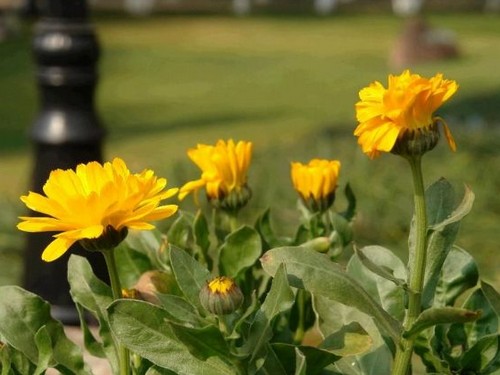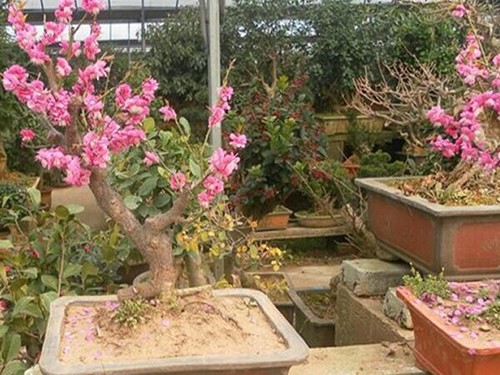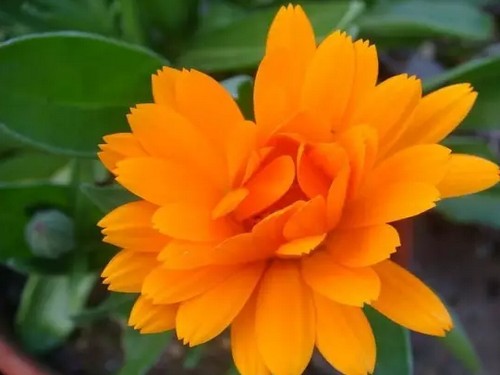Culture method of calendula (Calendula)
Calendula, also known as marigold, is a plant of the genus Calendula in Compositae. It is often used in flower beds and is native to southern Europe. Calendula is one of the common flower plants with bright colors, and it is not uncommon for potted plants to decorate the house. it is suitable for flower beds and flower belts, and can also be used as lawn border flowers or potted plants to watch. Long pedicel large flower species can be used to cut flowers. Let's take a look at the culture method of marigold.

The culture method of calendula:
1. Soil: soil that is not strict with soil and can withstand barren and drought. Loose, fertile and slightly acidic soil is the best. Instead of soil, sandy loam or culture soil with fertile, loose and good drainage is suitable, and the soil pH of 6-7 is the best. In this way, the plant has many branches and blossoms.
2, sunshine: like the sun, strong adaptability, afraid of hot weather, summer should be appropriate shade. The three seasons of spring, summer and autumn need to be maintained in shade. When the temperature is higher (the daytime temperature is above 25 ℃), if it is maintained in direct sunlight, the leaves will obviously become smaller, the branches will shorten, the foot leaves will yellowing and fall off, and the growth will be very slow or enter a semi-dormant state. It is necessary to give direct sunlight in winter to facilitate photosynthesis and the formation of flower buds, flowering and fruiting.
3. Temperature: like warm climate, the most suitable growth temperature is 15-25 ℃, avoid extreme heat, obviously grow poorly when the summer temperature is higher than 34 ℃, do not tolerate frost and cold, and enter dormancy or death when the winter temperature is below 4 ℃.
4. Humidity: the relative humidity of the air must be kept at 75-85% after cutting. You can increase the humidity by spraying the cuttings 1-3 times a day, the higher the temperature in sunny days, the more times you spray, and the lower the temperature in cloudy and rainy days, the less or no spraying. But with excessive spraying, cuttings are easy to be infected by bacteria and rot, because many kinds of bacteria exist in the water.
5. Watering: water can be watered once a week in spring and autumn to keep the basin soil moderately moist. Watering in summer is about twice a week, and plants need to be sprayed frequently. Watering in winter is usually about once every 10 days.
6. Fertilization: 7-10 days after planting, coring promotes branching or spraying the leaf surface with 0.4% solution for 1-2 times to control the plant height. Fertilize once every semimonthly during the growing period, or use "Huiyou" 20-20-20 general fertilizer. There is plenty of fertilizer, and the calendula blossoms more and more. On the contrary, due to the lack of fertilizer, the flowers became significantly smaller and degraded. After seasonal germination, thin rotten fecal water was applied once a week, and 10 times of rotten urine was applied every 15 to 30 days during the growth period, and fertilized until the end of February. Sufficient fertilizer can make calendula blossom more and the flowers are huge.
7. Pruning: cut off the branches with old and yellow leaves every two months, as long as the temperature is right, it can blossom all the year round.
8. Diseases and insect pests: the common diseases and insect pests are Fusarium wilt, downy mildew and rust, which are easily harmed by red spiders and aphids in early spring. Indoor cultivation is often caused by Fusarium wilt and downy mildew due to poor ventilation and high humidity, which can be controlled by spraying 65% zinc wettable powder 500 times. When the temperature rises in early summer, rust damage is often found in the leaves of golden chrysanthemum, which is sprayed with 2000 times of the wettable powder. Early spring florescence is vulnerable to red spiders and aphids, which can be sprayed 1000 times with 40% omethoate emulsion.
Calendula flower color is rich and colorful, potted planting can be used to decorate in the home room, marigold culture methods to introduce to you here, I believe you have a certain understanding of marigold culture.
Time: 2019-06-01 Click:
- Prev

Culture methods and matters needing attention of Prunus mandshurica
It is widely used in Beijing gardens to reflect the prosperity of beautiful spring and flowers. Should be planted in the park grass, roadside, or garden in the corner, pool, and so on. If the elm leaf plum is planted in front of evergreen trees, or planted in the mountains and rocks, it can produce a good ornamental effect. Planting with Forsythia suspensa
- Next

Culture methods and matters needing attention of potted Calendula
With short plants, dense flowers, bright colors and long flowering period, calendula is the most common herbaceous flower in early spring gardens and cities. Calendula is one of the common flowers and plants with bright colors, and it is not uncommon for potted plants to decorate homes.
Related
- Fuxing push coffee new agricultural production and marketing class: lack of small-scale processing plants
- Jujube rice field leisure farm deep ploughing Yilan for five years to create a space for organic food and play
- Nongyu Farm-A trial of organic papaya for brave women with advanced technology
- Four points for attention in the prevention and control of diseases and insect pests of edible fungi
- How to add nutrient solution to Edible Fungi
- Is there any good way to control edible fungus mites?
- Open Inoculation Technology of Edible Fungi
- Is there any clever way to use fertilizer for edible fungus in winter?
- What agents are used to kill the pathogens of edible fungi in the mushroom shed?
- Rapid drying of Edible Fungi

